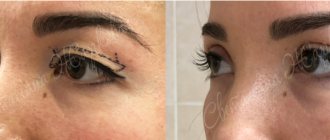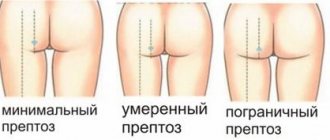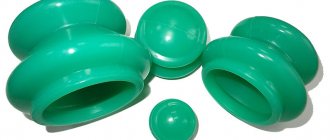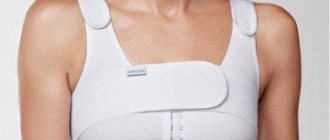Firm, rounded buttocks are an attractive part of the body for a person of any gender and age. You can deny this fact as much as you like, but animal instincts will always force us to pay attention to this “detail” of our own and others’ figures.
Everyone has different tastes. Some people like “butts like a nut”, others like round and soft ones. In recent years, there has even been a certain cult of buttocks - spherical and hard, like bowling shells. To achieve this ideal, people, especially women, are willing to literally live in gyms.
However, not everyone can train fiercely for months to achieve the perfect body. And it’s not always possible to pump up your “dream butt” with squats. If by nature a person is given one shape of buttocks, but he dreams of a completely different one, the situation cannot be corrected without outside intervention.
In such a situation, only surgery can help - buttock plastic .
1
Consultation with a plastic surgeon
2 Plastic surgery for buttock correction
3 Plastic surgery for buttock correction
What is gluteoplasty and why is it needed?
Gluteoplasty is a surgical procedure to correct the size and shape of the buttocks, as well as tighten them.
It is divided into several types. Most often, women resort to such plastic surgery, but it is not contraindicated for men either. Experts in the field of plastic surgery note that representatives of the stronger sex have recently shown serious interest in this type of intervention. It involves a number of subtleties, and its implementation should be trusted only to a professional.
Why is buttock surgery performed?
The roundness and elevation of the buttocks are ensured by dozens of muscles and ligaments, not only the gluteal ones, but also partly the femoral ones. Over the years, the muscles in this area sag, resulting in a deterioration in shape and volume. The situation can be corrected surgically.
The buttock lift procedure helps eliminate sagging soft tissues and correct cosmetic skin defects. However, if the goal is to reshape and add volume to flat buttocks, a more radical operation called gluteoplasty . The essence of this surgical intervention is the correction of the buttocks using silicone implants.
Indications for buttock surgery:
- scars, stretch marks and other skin defects of the buttocks;
- loss of volume, ptosis of soft tissues, sagging skin in the area;
- congenital or acquired asymmetry and deformation of the buttocks;
- flat buttocks, unaesthetic shape of the buttocks.
Indications and contraindications
Gluteoplasty does not require any medical indications. It belongs to aesthetic surgery, so it can be performed on any patient who wants to give volume and a beautiful shape to the buttocks.
Typically, people who have the following problems with their buttocks undergo surgery:
- flat or unattractive shape;
- saggy and flabby butt;
- ptosis;
- presence of depressions;
- asymmetrical buttocks.
Surgical intervention also has contraindications:
- pregnancy and lactation;
- bleeding disorders;
- infections and inflammatory processes in the body;
- diseases of the kidneys and endocrine system.
Possible problems
The probability of developing complications is perceived as problems, we list them:
- the appearance of rough scars that narrow the anus;
- spontaneous opening of the abscess and outflow of pus into the vagina or rectum;
- involvement of nearby organs and tissues in the inflammatory process, more often the pelvic tissue becomes inflamed;
- disruption of the urination process due to the outflow of purulent masses into the urethra;
- suppuration of sutures, leading to sepsis, peritonitis;
- the addition of a secondary infection, the transition of the disease to a chronic form.
A non-dangerous complication is sphincter weakness, which is observed in a large number of patients who have undergone such an operation. It leads to incontinence of gas and stool. Special gymnastics will help get rid of the problem.
Recommended video:
Kinds
Gluteoplasty has several main types. They differ depending on the technology, but each of them is aimed at correcting the volume and shape of the buttocks.
Implantation
The most common method, the advantage of which is that along with shape correction, you can also significantly increase the volume of the buttocks. The surgeon sews special implants or the patient’s own fat into the soft tissue.
The last option is considered more gentle, but it is not always possible. In structure and shape, buttock implants are not much different from breast implants. But they are larger in size and so on. Their shape can be round, oval or teardrop-shaped.
- Round implants help give the buttocks volume and a beautiful shape. However, they are static and do not adapt to human movements. Incorrectly selected implants can cause a disproportionate figure.
- Oval ones have a similar effect, but do not have the disadvantages of large implants, so they are considered the best option.
- Drop-shaped ones are used when it is necessary to restore the shape of the butt after damage and injury.
Lifting
Lifting involves tightening the skin on the buttocks. To perform the operation, the surgeon makes incisions in the gluteal folds. There are no scars left after the operation. This method is usually used for ptosis (tissue drooping).
Mesotherapy
With mesotherapy, shape correction and lifting of the buttocks occurs due to special mesothreads. This is the most gentle technique, but it cannot always provide such impressive results as implants.
Ideal buttock shape, is it possible?
As the famous movie heroine said: What makes a woman a woman? Only she meant the gait, but you and I know what men pay attention to first of all. These are beautiful breasts and elastic buttocks. And what to hide, we women also always appreciate a rounded male butt. Is not it?
But what to do if nature decided to rest precisely at the moment when it created the “view from the rear”.
After all, a flat butt and a floating contour of the buttocks are a frequent reason for the development of complexes. You can seek the help of a plastic surgeon. Many clinics now perform buttock augmentation with implants. I even found out what this operation is called - gluteoplasty. Important information! The price of the life-saving procedure depends on the cost of the implants, additional services offered and the region.
On average, to create the perfect butt, you need to be prepared to spend from 70 to 200 thousand rubles. Not only women resort to gluteoplasty. Men want to have a beautiful body no less than we do. In general, plastic surgery on the butt area is performed in the following cases:
- hypoplasia or aplasia. This is when the gluteal muscles are underdeveloped or almost completely absent;
- with deformation of the buttocks after injury;
- asymmetrical location of the gluteal muscles;
- atrophic muscle changes;
- insufficient buttock size and loose skin.
But I want to say right away that there are more loyal ways to make your butt beautiful. For example, you can use special underwear: push-up panties or shorts.
Preparation for surgery and tests
Before the procedure, the patient must undergo a number of tests:
- general blood analysis;
- general urine analysis;
- blood chemistry;
- coagulogram;
- blood test for HIV, syphilis, hepatitis.
You also need to undergo fluorography and cardiogram.
Two weeks before surgery, it is recommended to avoid alcohol and medications that affect blood clotting. You cannot adhere to a strict diet, since restrictions can negatively affect the immune system, making recovery worse for the body.
8 hours before surgery you need to stop eating. The night before visiting the surgeon, it is recommended to take sleeping pills or a sedative.
Rehabilitation period
After returning home from the clinic, a recovery period begins, which lasts up to six months. To ensure that the joy of owning a new butt is not overshadowed by anything, you will have to follow some rules:
- special shapewear cannot be removed for at least two months;
- You shouldn’t sit down for a week, you can only lie down, and for several days only on your stomach;
- regularly treat sutures using healing and anti-inflammatory drugs recommended by your doctor;
- for at least three days you should not wet the stitches, and therefore take a bath or shower;
- Avoid physical activity for 4-5 weeks.
After installation of buttock implants, intramuscular injections can only be made in the femoral area. You can't give injections in the butt anymore.
Step-by-step instructions: how is the procedure performed?
The course of the procedure differs depending on the chosen technique. Let's look at how gluteoplasty is done in each individual case.
Augmentation with implants
Implantation is done under general or spinal anesthesia. The algorithm is as follows:
- The doctor makes small incisions up to 5 cm in the intergluteal fold and creates pockets for dentures.
- Through the incisions, the implants are placed in pre-agreed locations. It is important that the cavity in which the implant is placed does not extend beyond the gluteal muscle.
- After installation of the endoprosthesis, the incision is sutured with self-absorbing sutures.
The operation lasts 1.5-2 hours.
Augmentation with own fat
This procedure is known as lipofilling. It is done like this:
- The specialist takes the cells for transplantation. Typically the donor site is the abdomen or thighs. Fat cells are obtained by liposuction: the doctor inserts thin cannulas under the skin through which the fat is pumped out. Depending on the volume, the operation can be performed under either local or general anesthesia.
- Adipose tissue is cleansed of biological impurities. The doctor then draws the treated material into syringes.
- Next, the purified cells are introduced into the thickness of the hypodermis of the buttocks using long cannulas and distributed evenly.
The operation takes about 2-4 hours.
Lifting
During a surgical buttock lift, the doctor first selects a technique and makes markings on the patient’s body.
In accordance with it, cuts are made. There are several types of lifting. The lift can be upper, when the hips and upper outer sections are tightened. This method is relevant if defects are present only in the upper zones.
Lateral lift makes it possible to eliminate moderate ptosis and restore the elasticity of the tissues of the upper sections.
One of the most popular variations is the medial lift or Butterfly:
- The specialist makes cuts along markings similar to butterfly wings.
- An autoprosthesis is created from muscle fiber.
- The doctor covers it with a skin flap, removes excess fat and tightens the skin.
- The dermis is then sutured by aligning the edges of the wound.
Rehabilitation period
After the operation is completed, you need to go through a rehabilitation period. It assumes the following rules:
- In the first 2-3 days after plastic surgery, you should not sleep on your back. Otherwise, deformation of the created shape, divergence of seams and severe pain are possible.
- You should also not shower for the first three days. For 5-7 days, it is recommended to remain in a lying position most of the time, but not on your back.
- For 4-6 weeks you cannot visit saunas, steam baths and solariums.
- In the first 2-3 weeks, it is recommended to minimize sitting. If you have a sedentary job, it is recommended to have surgery while on vacation.
- It is recommended to wear slimming compression garments for 1.5 months.
- You can start physical activity only 2 months after the operation.
- For a couple of months, injections into the buttocks should not be performed. If implantation has been performed, they cannot be performed for life or while implants are in the buttocks.
- For scars, you can use medications recommended by your doctor. In case of severe pain, you can take a pain reliever.
It takes 4-6 months for the body to fully recover. During the rehabilitation period, swelling, pain, and, in some cases, numbness of specific areas may appear. You can return to work, including sedentary work, after 2-3 weeks.
After buttock surgery
After surgical correction of the buttocks, pain and decreased sensitivity may persist in the intervention area for 2-3 days. No sitting is allowed for at least 7 days.
After 14 days, the patient can return to their normal lifestyle. However, you should refrain from physical exercise for at least 1.5 months. And it is recommended to wear special compression garments for at least the same amount of time.
MedicCity offers a full range of plastic surgeries and cosmetic procedures for the face and body. Our plastic surgeons are recognized masters of their craft, professionals of the highest class! The cost is average in Moscow. If you are choosing a specialist to whom you want to entrust the correction of your buttocks, read reviews of the clinic’s plastic surgeons.
Photos before and after surgery
Below are photos before and after the procedure to correct the size and shape of the butt, as well as lifting the buttocks.
Who are contraindicated for implants?
Do you think that anyone can change the shape of their buttocks with plastic surgery? Not so. In some cases this is simply prohibited.
You will have to forget about plastic surgery if:
- there are blood diseases;
- there are problems with blood vessels and the heart;
- carbohydrate metabolism disorders were diagnosed;
- there is excess weight and not just a few extra kg, but obesity;
- Skin transplantation was performed in the buttock area;
- an inflammatory process and suppuration develop in the buttocks;
- malignant neoplasms have been detected in the body;
- Chronic internal diseases have worsened.
Important nuance! The fulfillment of the desire to have a butt with implants will have to be postponed until adulthood.
Side effects and complications
Gluteoplasty can cause side effects. Some of them do not pose a danger and go away on their own, while others require action. After buttock augmentation, the following reactions may occur:
- Hematomas. The appearance of hematomas is associated with vascular damage during surgery. They are removed surgically. The specialist removes the accumulation of blood, washes the bed and cauterizes the vessel. At the end of the operation, a drainage is installed for several days.
- Asymmetry. Most often it occurs when implants are installed under the gluteus maximus muscle. In addition, uneven placement may result from other complications. In this case, a repeat operation is required.
- Infection. It is a consequence of violation of the surgical technique and the use of non-sterile materials and instruments. In this case, you need to remove the implant and thoroughly rinse the infected area with an antiseptic. Drainage and antibiotics are also necessary. Repeated surgery is possible no earlier than after 6-12 months.
- Temperature. The temperature may rise immediately after surgery or after a couple of days. For 5-7 days it can remain at a subfebrile level of 37.5-38 degrees and not rise. In this case, there is no cause for concern. If the temperature does not go away or rises, you need to undergo examination. A course of antibiotics may be needed.
- Pain. It is normal to feel pain for several days after surgery. They go away on their own. It is permissible to take a painkiller. If the pain persists for a long time, you need to consult a specialist.
- Seroma. Seroma is an accumulation of fluid between the soft tissue and the implant.
The likelihood of its occurrence increases if the rules of the rehabilitation period are not followed. Most often, seroma occurs during the first two weeks after the intervention, but it may appear at a later date. An ultrasound is performed for confirmation. There is only one treatment method - installation of a drainage system in the implantation pocket for 3-6 days. Antibacterial and anti-inflammatory drugs are also prescribed. With proper timely treatment, seroma can be cured in 5-7 days. Otherwise, infection, fibrosis and the formation of capsular contracture are possible.
Patient hygiene
Hygiene rules will help to avoid the addition of a secondary infection, they are as follows:
- When using antiseptics, solutions are used regularly until the damage is completely healed. Antiseptics stop the growth and reproduction of pathogenic microorganisms.
- While washing. It is recommended to carry out them at least 2 times a day, using warm water. You can give preference to herbal decoctions, use: chamomile, oak bark, plantain.
- In changing bed and underwear, which is carried out daily. Preference is given to natural fabrics.
Failed operation
The main signs of unsuccessful gluteoplasty are asymmetry of the implants, their rupture and rejection. It is also possible that the sensation in the buttocks may decrease or be completely lost. If the rehabilitation period has already ended, and the result is not as expected, you should consult a specialist. In some cases, if butt surgery is unsuccessful, the problem can only be solved by repeated surgery.
Negative consequences are most often the result of the surgeon’s incompetence or failure to comply with contraindications. To minimize their risks, you need to consider the following recommendations:
- Choose the right specialist. Don't be tempted by the low price. Study the doctor's portfolio and reviews about him.
- Before the procedure, you need to tell the specialist about all existing diseases, lifestyle habits, medications, etc.
- It is important to adhere to all the rules of the rehabilitation period. You should not return to your normal lifestyle earlier than recommended by your doctor.
Doctor's recommendations
Experts believe that, in general, gluteoplasty is a safe plastic surgery that allows you to quickly achieve results and acquire the desired shape. The risk of complications, of course, exists, but as a rule these are isolated cases and are most often caused by patients’ non-compliance with doctor’s recommendations.
However, you can reduce the risk by carefully choosing a clinic and a plastic surgeon who will perform the operation and following all the rules of the recovery period. In any case, you should not agree to install an implant under the skin; this most often leads to the capsule becoming overgrown with connective tissue.











